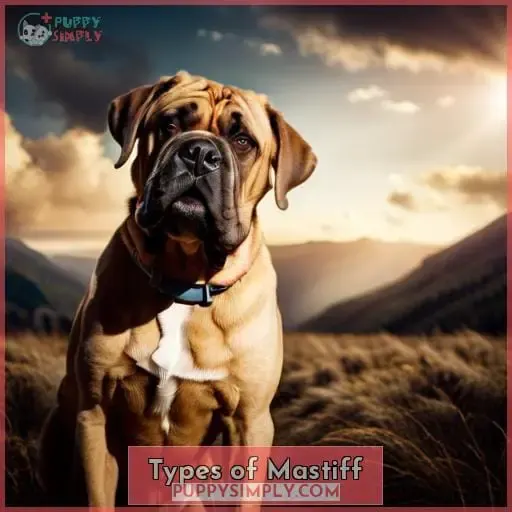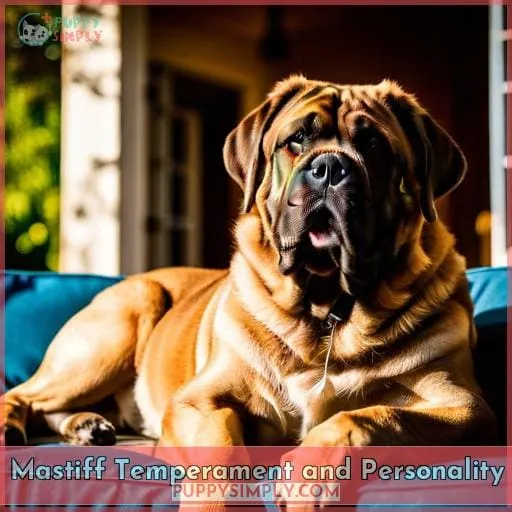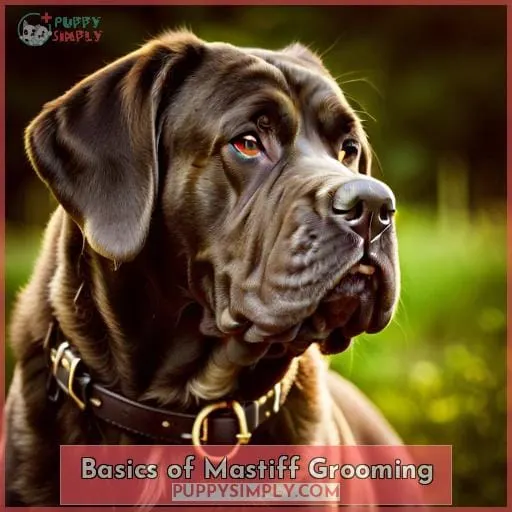This site is supported by our readers. We may earn a commission, at no cost to you, if you purchase through links.
 Imagine owning an English Mastiff, a gentle giant with a loving and affectionate nature. This article is your go-to guide for everything you need to know about English Mastiffs: their facts, types, temperament, and more.
Imagine owning an English Mastiff, a gentle giant with a loving and affectionate nature. This article is your go-to guide for everything you need to know about English Mastiffs: their facts, types, temperament, and more.
Discover the different types of mastiffs and learn about their history as working dogs turned beloved companions. Understand their calm demeanor and remarkable size that make them wonderful family pets.
Get ready to delve into the world of English Mastiffs!
Table Of Contents
- Key Takeaways
- Quick Facts
- Types of Mastiff
- Mastiff Pictures
- Factors to Consider for Apartment Living
- More Quick Facts
- The History of Mastiffs
- Mastiff Temperament and Personality
- Understanding Mastiff Health
- Basics of Mastiff Grooming
- Finding and Choosing a Mastiff
- Frequently Asked Questions (FAQs)
- Can English Mastiffs live in apartments or small living spaces?
- How much exercise does an English Mastiff need on a daily basis?
- Are English Mastiffs good with children and other pets?
- What are some common health issues that English Mastiffs are prone to?
- How much does an English Mastiff typically weigh?
- Conclusion
Key Takeaways
- Origin dates back to medieval England.
- Prone to health conditions: hip dysplasia, bloat.
- Training responsiveness to firm, patient guidance.
- Suitable for families with children.
Quick Facts
Let’s dive into the quick facts about the English Mastiff, a remarkable breed known for its size and gentle nature.
With historical significance dating back to medieval England, this gentle giant is one of several unique mastiff breeds.
When it comes to training tips, they respond well to firm yet patient guidance.
However, health considerations are important with this breed as they’re prone to conditions such as hip dysplasia and bloat.
Despite some common myths surrounding them, English Mastiffs have a loving temperament that makes them excellent companions for families with children.
They can weigh over 200 pounds and have an average lifespan of 10-12 years.
Types of Mastiff
What are the different types of Mastiffs you can find?
There are several distinct breeds that fall under the category of Mastiff. In addition to the English Mastiff, other popular types include the Neapolitan Mastiff, Bullmastiff, Tibetan Mastiff, and Dogue de Bordeaux.
Each breed has its own unique characteristics and traits that distinguish it from others in terms of size, temperament, genetic issues, and health considerations.
- The Neapolitan Mastiff is known for its large size and loose skin folds.
- The Bullmastiffs were originally bred as gamekeepers’ night dogs.
- Tibetan mastiffs are ancient guardian dogs with a thick double coat.
- Dogue de Bordeaux is a powerful French breed used for guarding properties.
It’s important to research each type thoroughly before deciding which one would be most suitable for your lifestyle and needs.
Mastiff Pictures
To give you a visual representation of the majestic English Mastiff, here are some captivating pictures showcasing their massive size and powerful build.
You’ll see adorable mastiff puppies, with their wrinkled faces and pudgy bodies that will melt your heart.
These gentle giants come in various colors, including fawn, apricot, brindle, and sometimes even black or blue.
Their impressive size is evident in these photos as they tower over humans with ease.
When it comes to training the strong-willed mastiffs require firm yet patient guidance to develop good manners and obedience skills.
Despite their intimidating appearance, they’ve a calm temperament making them suitable for families with children if properly socialized from an early age.
Factors to Consider for Apartment Living
If you’re considering apartment living with an English Mastiff, there are several factors to keep in mind.
First, their all-around friendliness and compatibility with families make them a good choice for apartment dwellers.
However, their large size and exercise needs require sufficient space and regular physical activity to prevent behavioral issues.
Additionally, their health and grooming needs should be taken into consideration as well as addressing any prey drive or behavioral concerns through proper training.
All-around Friendliness
Consider the English Mastiff’s all-around friendliness when deciding if it’s suitable for apartment living.
Despite their large size, these Gentle Giants can adapt well to smaller living spaces with proper exercise and socialization.
They’re known for being loyal dogs and good with kids, making them playful companions for families.
With their protective nature and focus on family, English Mastiffs can be a great choice for those looking for canine compatibility in an apartment setting.
Remember to provide ample exercise opportunities and follow socialization tips to ensure a happy living environment.
Compatibility With Families
When considering the compatibility of English Mastiffs with families, it’s important to take into account their suitability for apartment living.
Despite their large size, English Mastiffs can adapt well to apartment life if given sufficient exercise.
They’re good with kids and known as gentle giants due to their patient and protective nature.
These loyal and affectionate dogs make excellent guard dogs while also being obedient and family-oriented.
Health and Grooming Needs
If you’re living in an apartment and considering getting an English Mastiff, it’s important to be aware of their health and grooming needs. Here are some key factors to consider:
Health Checks
- Regular check-ups with a veterinarian are crucial for maintaining your mastiff’s overall health. They may recommend specific tests or vaccinations based on the breed’s predispositions.
Dietary Considerations
- A balanced diet is essential for keeping your mastiff healthy. Consult with a vet about the appropriate portion sizes, types of food (dry kibble vs wet), and any dietary restrictions or supplements that may benefit your dog.
Exercise Routine
- Mastiffs require regular exercise to keep them physically fit and mentally stimulated.
- Plan daily walks or playtime sessions in a fenced yard.
- Avoid excessive high-impact exercises due to joint problems common in large breeds like hip dysplasia.
Grooming Tips
- Regular coat care helps maintain the healthiness of their skin & fur:
- Brushing at least once a week removes loose hair & prevents matting.
- Bathing should only be done when necessary as over-bathing can strip natural oils from their coat.
- Check ears regularly for signs of infection or wax buildup; clean gently if needed.
Overall, being attentive to these aspects will ensure that your English Mastiff stays happy, healthy, and comfortable while living in an apartment setting.
Trainability
For apartment living, training an English Mastiff is essential.
Despite their gentle and loyal nature, these massive dogs can present behavioral challenges if not properly trained.
To ensure a well-behaved and obedient companion, it’s important to employ positive reinforcement techniques and consistency in training.
Establishing yourself as the pack leader is crucial for effective obedience training.
Seek guidance from a reputable breeder or professional trainer for trainability tips specific to English Mastiffs’ temperament.
Addressing Prey Drive and Behavioral Concerns
To address prey drive and behavioral concerns in an apartment living situation, consider providing mental stimulation and outlets for exercise. This will help keep your English Mastiff engaged and prevent boredom-related behaviors.
Additionally, socialization techniques can be used to expose your mastiff to different people, animals, and environments from a young age.
Behavioral training should focus on teaching appropriate behavior around prey-like objects or small animals. It’s important to understand the unique challenges of managing prey drive in this breed during dog training.
- Provide mental stimulation
- Socialize from a young age
- Focus on behavioral training
Exercise Needs
To ensure a healthy and happy English Mastiff in an apartment setting, it’s important for you to consistently provide regular exercise.
Despite their giant size, Mastiffs can adapt well to indoor living as long as they receive adequate physical activity. Engage them in outdoor activities such as daily walks or play sessions to release mental and physical energy.
Training tips and socialization techniques are also essential for their overall well-being.
More Quick Facts
Now let’s dive into some additional quick facts about the English Mastiff, so you can get a more comprehensive understanding of this remarkable breed.
The origins of the Mastiff can be traced back to ancient times, with depictions found in Babylonian and Egyptian civilizations over 2,500 years ago.
When it comes to size variations, English Mastiffs are known for their massive build and can weigh anywhere from 130 to over 220 pounds.
Like many large breeds, they do face certain health challenges such as hip dysplasia and bloat (gastric torsion).
Training tips include being firm yet gentle with them while achieving pack leader status through consistent training methods.
The History of Mastiffs
Continue exploring the fascinating world of Mastiffs with a dive into their rich history, spanning over 2,500 years.
The ancient origins of Mastiffs can be traced back to medieval times and even further. These magnificent dogs have played a significant role in canine history, leaving behind a historical significance that can’t be ignored.
With their evolutionary influence on other breeds and their war dog legacy, mastiffs have had a profound cultural impact throughout the ages. From being used as protective dogs to guarding nobility and participating in ancient arenas, mastiff origins are deeply rooted in our past.
Understanding the history of English Mastiffs provides us with insights into their noble lineage and helps us appreciate these gentle giants even more.
Mastiff Temperament and Personality
As we delve into the temperament and personality of Mastiffs, it’s important to note that these gentle giants are known for their docility, loyalty, and courage.
- Guardian Instincts: Mastiffs have a natural instinct to protect their family and territory. Their imposing presence alone can be enough to deter potential threats.
- Child-Friendly: Despite their size, mastiffs are generally patient and excellent with children. However, supervision is still crucial due to accidental overpowering.
- Training Challenges: While they’ve a desire to please their owners, mastiffs can be slow when responding in training sessions compared t other breeds.They require firm yet gentle handling along with patience during training sessions.
- Silent Vigilance:Mastiff dogs don’t bark much but instead maintain silent vigilance over its surroundings.This makes them effective guard dogs without disturbing your neighbors or environment excessively
Remember that individual temperaments may vary within this breed; adopting from reputable rescues or working with certified breed organizations is recommended for finding well-tempered individuals.
Understanding Mastiff Health
To better care for your English Mastiff, it’s important to understand their specific health considerations.
- Diet and Exercise
- Preventive Care
- Common Conditions
- Regular Check-ups
- Emergency Preparedness
Maintaining a balanced diet and providing regular exercise are crucial for the overall well-being of your Mastiff. Proper nutrition will help prevent obesity, which can lead to joint issues such as hip dysplasia.
Additionally, regular exercise helps keep them physically fit and mentally stimulated.
Preventive care includes vaccinations, flea/tick prevention, dental hygiene practices like brushing teeth regularly or offering dental chews.
Common conditions that affect Mastiffs include hip dysplasia (a genetic disorder), bloat (gastric torsion), eye problems like progressive retinal atrophy (PRA), heart disease (cardiomyopathy) among others.
Regular check-ups with a veterinarian are essential in identifying any potential health concerns early on and preventing serious complications down the line.
Lastly, being prepared for emergencies by having a first aid kit specifically tailored for dogs is vital. Being familiar with basic pet CPR techniques can also be life-saving in critical situations.
Basics of Mastiff Grooming
To maintain the health and appearance of your English Mastiff, it’s important to understand the basics of grooming.
-
Brushing Technique:
- Regular brushing is essential for keeping your Mastiff’s coat healthy and free from tangles.
- Use a firm bristle brush and work through their thick fur in sections, paying extra attention to areas prone to matting.
-
Coat Maintenance:
- The smooth, short-haired coat of an English Mastiff is generally easy to groom.
- However, they’re average shedders, so regular brushing will help control shedding and keep their coat looking its best.
-
Grooming Tools:
- Invest in high-quality grooming tools such as a slicker brush or shedding tool specifically designed for large breed dogs like the Mastiff.
- These tools will make grooming sessions more effective and comfortable for your furry friend.
Remember that proper grooming not only helps with maintaining their appearance but also promotes bonding between you and your mastiff.
Finding and Choosing a Mastiff
When it comes to finding and choosing a Mastiff, there are a few options available.
- You can choose to work with a reputable breeder who specializes in English Mastiffs, ensuring that the puppies come from healthy bloodlines and have been properly socialized.
- Another option is adopting from a Mastiff rescue or shelter, where you can provide a loving home for an adult dog in need.
Both choices require careful research and consideration to ensure you find the right companion for your lifestyle and preferences.
Choosing a Mastiff Breeder
When finding and choosing a Mastiff, it’s important to carefully select a reputable breeder.
Breeder selection is crucial for ensuring the health and well-being of your future pet.
Look for breeders who prioritize health screening, including tests for hip dysplasia and other common genetic issues.
Lineage verification is also essential to ensure you’re getting a purebred Mastiff with the desired temperament and coat color.
Make sure to visit the breeder’s facility in person to assess cleanliness and conditions before signing any contracts or making commitments.
Adopting From a Mastiff Rescue or Shelte
If you’re considering adopting a Mastiff from a rescue or shelter, there are several factors to consider.
Mastiff rescue groups and shelters have heartwarming success stories of finding these gentle giants their forever homes. Through mastiff matchmaking, dedicated organizations ensure that the dogs are placed with suitable families who understand the unique needs of this breed.
When adopting, it’s important to follow adoption tips and guidelines provided by the rescue or shelter to ensure happy endings for both you and your new furry friend.
Frequently Asked Questions (FAQs)
Can English Mastiffs live in apartments or small living spaces?
Yes, English Mastiffs can adapt to living in apartments or small spaces as long as they receive sufficient exercise.
However, it’s important to provide them with regular walks and mental stimulation to prevent them from becoming aloof or restless.
How much exercise does an English Mastiff need on a daily basis?
To keep your English Mastiff healthy and happy, aim for at least an hour of exercise each day.
This can include:
- Walks
- Interactive playtime
Regular physical activity is crucial to their well-being and helps prevent behavioral issues.
Are English Mastiffs good with children and other pets?
English Mastiffs are known to be good with children and other pets.
They’ve a gentle nature and are patient, making them excellent companions for families.
With proper socialization, they can get along well with other animals in the household.
What are some common health issues that English Mastiffs are prone to?
English Mastiffs are prone to various health issues, including:
- Hip dysplasia
- PRA
- Seizures
- Cystinuria
- Cancer
Gastric torsion (Bloat), a life-threatening condition, is also common.
Regular grooming and dental care are essential for their overall well-being.
How much does an English Mastiff typically weigh?
An English Mastiff typically weighs between 120 to 230 pounds.
These gentle giants are known for their massive size, making them a formidable presence and an impressive sight to behold.
Conclusion
To sum it up, the English Mastiff is truly a remarkable breed. With their gentle nature, remarkable size, and loving temperament, they make wonderful family pets.
Whether you live in an apartment or a spacious home, there are factors to consider when owning a Mastiff. From their history as working dogs to their health and grooming needs, it’s important to be well-informed before bringing one into your home.
Whether you choose to adopt or find a reputable breeder, the English Mastiff will surely bring joy and companionship to your life.
















